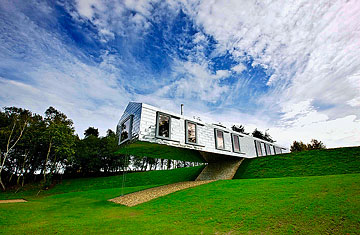
The playful Balancing Barn, created by innovative Dutch design firm MVRDV
Implausible as it may seem, holiday accommodation in rural England isn't limited to twee little cottages, somber stately homes and drafty old castles with terrible plumbing. Travelers who would rather not bed down in architectural museums can now instead stay in some living architecture — or perhaps that should be Living Architecture, the brainchild of Swiss broadcaster and writer Alain de Botton. It's a nonprofit initiative to plant contemporary holiday chalets throughout the country, each designed by a different cutting-edge studio.
Three were completed last year. The metallic Balancing Barn levitates over a Suffolk nature reserve. The Dune House struts asymmetrically on a popular stretch of Suffolk beach. The fashionably minimalist Shingle House stands alone and austere on a windswept Kent promontory. Each chalet sleeps eight or nine people, is fitted with designer amenities — Miele appliances, REN skin-care products and Peter Reed linen — and seeks to challenge the notion that rural architecture should consist of archaic forms, traditional materials and a hefty dollop of prettiness.
"Because Britain industrialized so fast, there's tremendous nostalgia for history," says de Botton. At the same time, he argues that there is no reason why the innovative approach taken in other fields of contemporary British design can't be employed in country living. "The architecture of our own times can have many of the qualities that people admire in buildings of old, like a sensory richness, a warmth, a connection with history," he says. "But they don't have to be museum pieces or kitsch."
Among projects planned for 2011 and 2012 are the Long House in Norfolk, by British modernists Michael and Patty Hopkins (who have drawn inspiration from the rugged salt-marsh landscape and the use of flint in the area's traditional buildings), and a "secular retreat" in Devon by Pritzker Prize — winning Swiss design maestro Peter Zumthor, who seeks to recreate the poise and mass of ecclesiastical architecture through the use of open forms and eco-friendly rammed concrete. See living-architecture.co.uk for more information — and rest assured there won't be a thatched roof, lace curtain or grandfather clock in sight.
